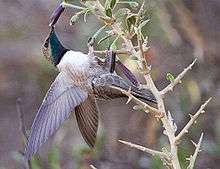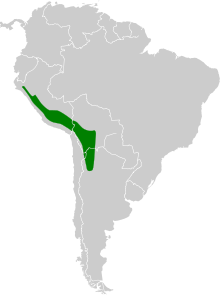Andean hillstar
The Andean hillstar (Oreotrochilus estella) is a species of hummingbird in the family Trochilidae. It is found in grassland, scrub and woodland in the Altiplano of southern Peru, Bolivia, northern Chile, and north-western Argentina.[2] It often includes the green-headed hillstar as a subspecies, but the male of that species has a black (not brown) stripe to the central underparts, and its upperparts are greener. Additionally, the green-headed hillstar is more closely related to the black-breasted hillstar and blue-throated hillstar than the Andean hillstar.[2][3]
| Andean hillstar | |
|---|---|
 | |
_perched.jpg) | |
| Male above, female below | |
| Scientific classification | |
| Kingdom: | Animalia |
| Phylum: | Chordata |
| Class: | Aves |
| Order: | Apodiformes |
| Family: | Trochilidae |
| Genus: | Oreotrochilus |
| Species: | O. estella |
| Binomial name | |
| Oreotrochilus estella d'Orbigny & Lafresnaye, 1838 | |
 | |
| Combined distribution (green) of Andean and green-headed hillstars in South America | |
The species is unusually well adapted to cold nights in the Andes, which it survives by reducing its metabolic rate utilizing a state of torpor to something like that of hibernation in sheltered niches facing the rising sun. If temperatures become too cold, they may seek shelter in nearby caves (which may be a limiting factor).[4] This shelter is also theorized to protect itself from nocturnal predation.[5]
Another trait that separated the Andean hillstar from many hummingbirds is its knack of perching when feeding on nectar as opposed to hovering. [4] This could have possibly evolved in order to save energy at such a high altitude.[5] Additionally the species differs where the females nest semi-colonially in close proximity with each other.[4] They feed on insects and the nectar of flowering plants, cacti, and even eucalyptus.[4] The species Chuquiraga spinosa likely evolved side by side with the Andean hillstar as this hummingbird is its primary pollinator in the winter.[5]
Subspecies
- stolzmanni Salvin 1895
- estella (d'Orbigny and Lafresnaye 1838)
- bolivianus Boucard 1893
See also
References
- BirdLife International 2016. Oreotrochilus estella. The IUCN Red List of Threatened Species 2016: e.T60946163A95164560. https://doi.org/10.2305/IUCN.UK.2016-3.RLTS.T60946163A95164560.en. Downloaded on 19 August 2019.
- Handbook of the Birds of the World. Vol. 5, J. del Hoyo, A. Elliott & J. Sargatal (eds.), Barcelona, 1999.
- Sornoza-Molina, F., J. F. Freile, J. Nilsson, N. Krabbe & E. Bonaccorso. 2018. A striking, critically endangered, new species of hillstar (Trochilidae: Oreotrochilus) from the southwestern Andes of Ecuador. Auk 135(4): 1146–1171.
- "Andean Hillstar". neotropical.birds.cornell.edu. Retrieved 2019-05-24.
- Carpenter, F. Lynn (1976). Ecology and Evolution of an Andean Hummingbird (Oreotrochilus estella) by F. Lynn Carpenter. University of California publications in zoology.
- Episode 2 of David Attenborough's "The Life of Birds", titled "Mastery of Flight".
External links
| Wikimedia Commons has media related to Oreotrochilus estella. |
| Wikispecies has information related to Oreotrochilus estella |
